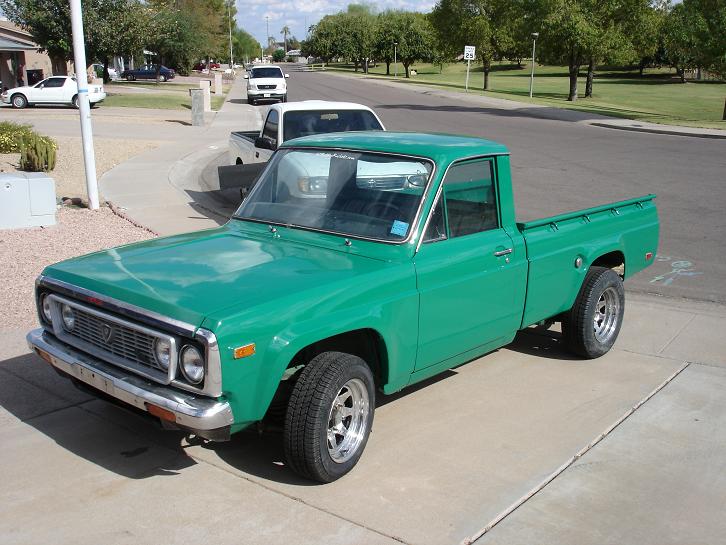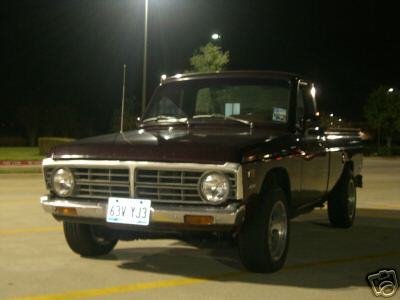
Under construction. I am adding loads of information from the original sales brocures on the year to year differences between models
Sales brochures for each year
General discussion about the Courier
Engine specs
Other specs
Details of Gen1 differences
Details of Gen2 differences
4x4 couriers
Electric Couriers
Diesel Couriers
The Mazda B-series -- before the Courier
The Mazda B-series -- after the Courier
Mazda Rotary Pickup
V6, V8, and other hotrod couriers
The other Ford Couriers
Current Ford Courier overseas
Other options -- flatbeds, stepsides, utility bodies,
RV's etc
 |
The Courier was manufactured by Toyo Kogyo (also known as Mazda), and imported and sold by Ford as a response to the unforseen popularity of the small Toyota and Nissan/Datsun pickups among young buyers in the west. Like the other mini-pickups of the time, it featured a sub-2 liter four cylinder engine, a four speed manual transmission, rear wheel drive, an impressive load capability considering its size, and a fairly large pricetag compared to full size pickups of the time. The Ford Courier sold for $3,000 when introduced -- close to the price of an F-100. |
| When it was introduced it came standard with a 1.8 liter overhead cam engine, which produced 74HP at 5000rpm, and 92ftlbs at 3500rpm. A 4 speed manual transmission was standard. The body styling, especially the front grill, was designed to reflect the styling of the F-series lineup of the time, so it obviously looked like a little Ford Truck. |  |
 |
The 1.8 liter (109.6 cu in) overhead cam engine produced 74 horsepower at 5,000rpm, and 92 ft-lbs of torque at 3,500rpm. It was a long stroke engine (3.07" bore x 3.7" stroke) with a chain driven cam shaft. It was coupled to a 4 speed manual transmission. For the first 5 years, this was all that was available. |
| The styling of the Courier's grill was designed to reflect the design of the F-series pickups of the time. Note the similarities to the 1973 F-100 pictured to the right. |  |
2nd gen courier -- In 1977 the Courier
was redesigned, and a host of new options was available. They now
had front disk brakes, a 2.3 liter engine option, automatic transmission
option, a 5 speed manual transmission option.In 1977 a 5 speed manual transmission
became available as an option. 1979 the engine was increased in size to
2.0 liters (120.1 cu in) with a xxxxx bore and stroke, producing xx horsepower
at xxxx rpm and xxx ft-lbs or torque at xxxx rpm. In 1977 Ford
also added one of their own engines to the lineup -- the 2.3 liter engine
(140.3 cu in) that was shared with the Ford Pinto and Mustang II.
The Ford 2.3 liter engine was one of the first all metric engines produced
in the US. An automatic transmission was also an option beginning
in 1977.
We need more info on the '77 - '82 couriers.
Guys who own one of these.....?
Original Sales Brocures from Ford Couriers
Click the picture for a hi res pdf file of the brochure
|
|
|
|
|
|
|
|
|
|
|
|
|
|
|
|
|
|
Design Details -- Gen 1 Couriers
Though the basic bodystyle was the same from 1972 to 1976, there are a number of small differences that can often tell them apart.
In 1972, the tailgate said Ford Courier in large letters

 |
In 1976 the cab was lengthened by 3
inches (so, if you want a 1st gen courier, but are over 6 foot tall, consider
a 76 over a 72-75)
Hmmmmmmmm |
Design Details -- Gen 2 Couriers
come on
people... give me some info here
Before there was Courier…

1971 B1600 and 1967 B1500 |
The Mazda B-series pickup was actually started in 1961 as the Mazda B1500/Mazda Proceed, with a 1.5 liter engine producing 59HP. In 1966 the body styling was changed, the engine was upgraded to 73HP, and in 1971 a 1.6 liter was introduced. |

1971 B1600 |
|
1972 Mazda B1600 |
In 1972, the body style was changed again, and it was imported to the US for the first time, under license from Ford, as the first Ford Courier. The Ford Courier was much the same as the new B1600, but with a larger 1.8 liter engine, and a different grill. Interestingly, the B1600 was rated for 1,000kg load (2,250lbs) -- more than 800 lbs more than the Ford Courier which was only rated for 1,400 lbs. |
|
The
Mazda Rotary Pickup
From 1974 to 1977 the Mazda version was also available with a 1.3 liter rotary engine producing 146 horsepower ?? – this version had flared fenders, disc brakes, and another different grill (www.mazdarepu.com) has more information on this truck |
 |
|
Four
wheel drive Ford Couriers
The
Ford Courier was never available as an OEM 4 wheel drive version in the
US (the Mazda B-series didn’t get 4 wheel drive until 1986). However, there
were several companies doing 4x4 conversions of the Ford Courier by adding
a transfer case and solid front axle beginning in 1975 . From 1975 to 1979
Northwest ATV in Kelso Washington converted about 1500 Couriers to 4WD,
which where sold as the Ford Courier Sasquatch, in the WA, OR, CA, and
ID markets only. (Ford Sasquatch
brochure). Other conversions of early 80's Couriers were done
by other companies as well.
|
|
These
were popular, however when the manufacturers began offering OEM 4x4 versions
of their small trucks, the higher cost of a conversion could not
compete. Toyota introduced a 4x4 truck in 1978, Isuzu in 1979, Datsun
in 1980, and Mitsubishi in 1982.
Note:
Toyota did have a 4x4 pickup truck sold in the US from 1963 to 1967, the
FJ-45 landcruiser, with a 6 cylinder engine, but by the 70's they did not
have a 4x4 pickup offering in the US.
|
 |
Diesel Ford Couriers
 |
The Ford Courier was never available with a diesel engine in the US. However, the 1980 Mazda B2200 was available with a Perkins 4.135 (4 cylinder, 135 cu in) manufactured 2.2 liter diesel engine, producing 66 horsepower at 2,100 rpm, and xxx ft-lbs of torque at xxx rpm. This same diesel engine was available in the 1983 and 1984 Ford Ranger, but was supplanted by the mitsubishi 4D55T 2.3 liter turbodiesel for the 1985 to 1988 Ford Rangers. Overseas, Mazda continued to develope their diesel engines, and the 2007 Ford Courier comes standard with a 2.5 liter turbodiesel engine, producing 110 horsepower at 3,500 rpm, and 200 ft-lbs of torque at 2,000 rpm. |
| Electric Ford Couriers
Between 1979 and 1982 a number of electric Ford Couriers were produced -- Jet Industries purchased "gliders" without engines, and put in a series DC motor and lead acid batteries, to produce the Jet Industries ElectraVan 750. These were sold mainly for service trucks to electric utilities and the like. They had a top speed around 70mph, and would go 50 to 60 miles on a full charge. A number of these are still around, usually with upgraded motor control systems and higher voltage battery packs. |
 |
| The California Stepside
conversion
A few Couriers were sold without a bed, to allow a chevy stepside bed to be added |
Couriers have been available or converted
to have utility bodies, flatbeds, and Uhaul box trucks



|
V8
Couriers
Yes,
a 302 (5.0 liter) Ford smallblock V8 fits in the engine compartment if
you are clever. A number of Couriers have been hotrodded with
V8 engines and new drivelines. Some people have also put various
V6 engines in the Courier
|
 |
The current Courier --
that's right. They are still available (till 2007) overseas. More
info